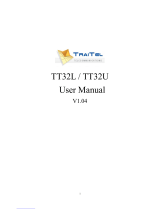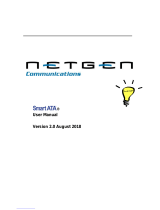
ATA-171/172/171P/171M (ATA-S1/S2/P/M)
User’s Guide
5
2 Keypad Interface for The ATA
You can use the PSTN phone keypad to operate the ATA. Please follow the instruction to configure
your terminal adapter.
Group IVR Action IVR Menu Choice Parameter(s) Notes:
Function Dial out from
PSTN Line 0* None Press 0* can pass call to PSTN
Line, user can dial out from PSTN
Line. (For 171P and 171M)
Function Unlock keypad
setting #190# None After you unlock keypad setting,
then you may configure the ATA.
Function Reboot #195# None After you hear “Option Successful,”
hang-up. The system will reboot
automatically.
Function Factory Reset #198# None
System will automatically reboot.
WARNING: ALL “User-Changeable”
NONDEFAULT SETTINGS WILL
BE LOST! This will include network
and service provider data.
Function Enable PPTP
client #116# None System will automatically reboot
and PPTP client will be enabled
Function Disable PPTP
client #117# None System will automatically reboot
and PPTP client wll be disabled
Function Enable VLAN #118# None System will automatically reboot
and VLAN will be enabled.
Function Disable VLAN #119# None System will automatically reboot
and VLAN will be disabled
Function Enable Call
Waiting #138# None System will automatically reboot
and Call Waiting will be enabled.
Function Disable Call
Waiting #139# None System will automatically reboot
and Call Waiting will be disabled.
Function Enable
Anonymous #140# None System will automatically reboot
and Send Anonymous CID will be
enabled.
Function Disable
Anonymous #141# None System will automatically reboot
and Send Anonymous CID will be
disabled.
Function Blind Transfer #510# None
Can only be performed in a phone
call conversation. For 171M, this
will transfer the current IP line to
another IP line.
Function Attendant
Transfer #511# None
Can only be performed in a phone
call conversation. For 171M, this
will transfer the line to IP from
PSTN (must be in IP mode to
execute this command)
Function 3-way calling (IP
Conference) #512# None Can only be performed in a phone
call conversation.
Function Attendant
Transfer #514# None
Can only be performed in a phone
call conversation. For 171M, this
will transfer the line to PSTN from
IP (must be in PSTN mode to
execute this command)
Info Check WAN IP
Address #126# None IVR will announce the current WAN
IP address of the ATA
Info Check LAN IP
Address #120# None IVR will announce the current LAN
IP address of the ATA
Info Check IP Type #121# None IVR will announce if DHCP in
enabled or disabled.
Info Check the Phone
Number #122# None IVR will announce current in use
VoIP number
Info Check Network
Mask #123# None IVR will announce the current
network mask of the ATA.
Info Check Gateway
IP Address #124# None IVR will announce the current
gateway IP address of the ATA.
Info Check Primary
DNS Server
Setting #125# None IVR will announce the current
setting in the Primary DNS field.
Info Check Firmware
Version #128# None IVR will announce the version of the
firmware running on the ATA.
Setting Set DHCP client #111# None The system will change to DHCP
























